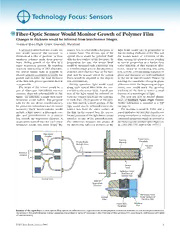
NASA Technical Reports Server (NTRS) 20110014684: Fiber-Optic Sensor Would Monitor Growth of Polymer Film PDF
Preview NASA Technical Reports Server (NTRS) 20110014684: Fiber-Optic Sensor Would Monitor Growth of Polymer Film
Technology Focus: Sensors Fiber-Optic Sensor Would Monitor Growth of Polymer Film Changes in thickness would be inferred from interference fringes. Goddard Space Flight Center, Greenbelt, Maryland A proposed optoelectronic sensor sys- control box to a fused-silica faceplate in light beam would vary in proportion to tem would measure the increase in a sensor head. The sensory tips of the the increasing thickness of the film and thickness of a film of parylene (a ther- optical fibers would be polished flush the known index of refraction of the moplastic polymer made from para-xy- with the free surface of the faceplate. In film, causing the photodetector reading lene) during growth of the film in a preparation for use, the sensor head to vary in proportion to a known sinu- vapor deposition process. By enabling would be mounted with a hermetic seal soidal function of film thickness. Elec- real-time monitoring of film thickness, in a feed-through port in the deposition tronic means of monitoring this varia- the system would make it possible to chamber, such that free face of the face- tion and the corresponding variation in identify process conditions favorable for plate and the sensory tips of the optical phase and thickness are well established growth and to tailor the final thickness fibers would be exposed to the deposi- in the art of interferometry. Hence, by of the film with greater precision than is tion environment. tracking the cumulative change in phase now possible. During operation, light would travel difference from the beginning of depo- The heart of the sensor would be a along each optical fiber from the con- sition, one could track the growing pair of fiber-optic Fabry-Perot interfer- trol box to the sensor head. A small por- thickness of the film to within a small ometers, depicted schematically in the tion of the light would be reflected to- fraction of a wavelength of light. figure. (In principle, a single such inter- ward the control box from the end face This work was done by Michael Beames- ferometer would suffice. The proposal of each fiber. Once growth of the pary- derfer of Goddard Space Flight Center. calls for the use of two interferometers lene film started, a small portion of the Further information is contained in a TSP for protective redundancy and increased light would also be reflected toward the (see page 1). accuracy.) Each interferometer would control box from the outer surface of This invention is owned by NASA, and a include a light source, a fiber-optic cou- the film. In the control box, the two re- patent application has been filed. Inquiries con- pler, and photodetectors in a control flected portions of the light beam would cerning nonexclusive or exclusive license for its box outside the deposition chamber. A interfere in one of the photodetectors. commercial development should be addressed to single-mode optical fiber for each inter- The difference between the phases of the Patent Counsel, Goddard Space Flight Cen- ferometer would run from inside the the interfering reflected portions of the ter, (301) 286-7351. Refer to GSC-14757-1. Fiber-Optic Coupler Fused-Silica Potting Single-Mode Material Faceplate Optical Fibers Parylene Film Electrical Outputs Photodetectors Sensor Head Reflection From Outside Inside End Face of Optical Fiber Control Unit Wall of Deposition Chamber Reflection From Optical Outer Surface of Fiber Parylene Film Fused-Silica Parylene Faceplate Film Portions of the Light Beam in each optical fiber would be reflected from opposite faces of the parylene and would interfere in one of the photodetectors. Variations in the photodetector output would be interpreted in terms of increases in the thickness of the parylene film according to well-known principles of interferometry. NASA Tech Briefs, January 2005 5
